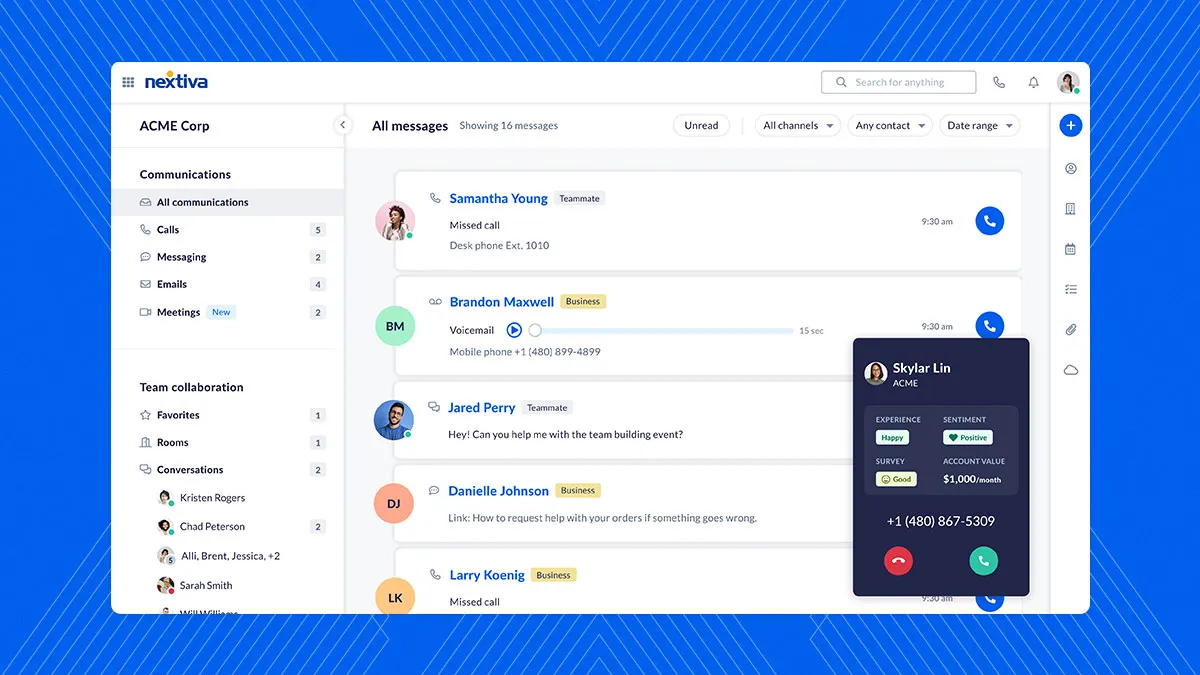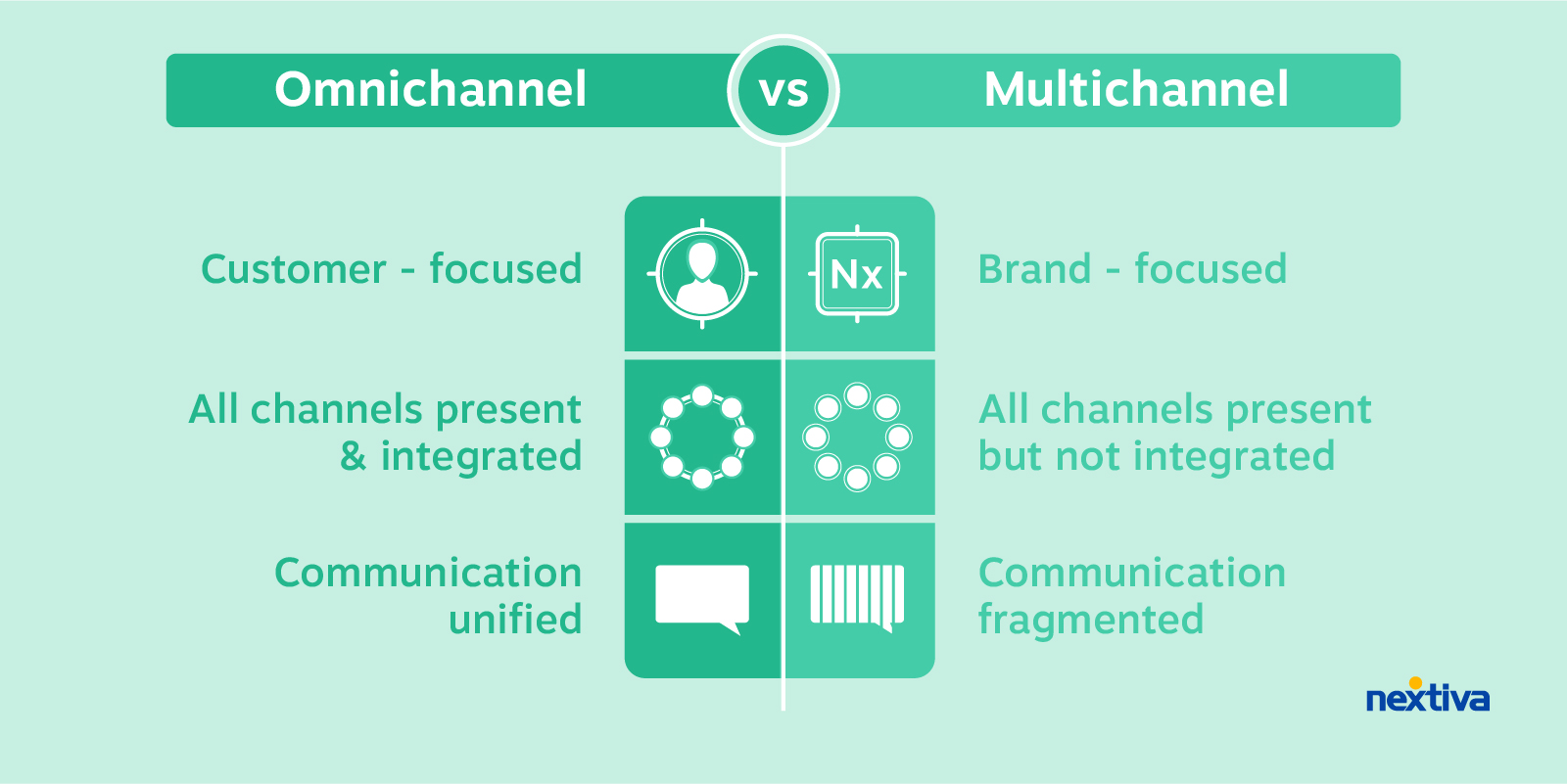As companies increasingly transition to cloud-based business communication solutions, understanding the differences between UCaaS vs CCaaS is important.
If you’re in the market for a new solution to replace your PBX, call center software or both, these two essential tools can have a significant impact on your organization’s efficiency and customer satisfaction.
In this post, we’ll compare Unified Communications as a Service and Contact Center as a Service, exploring their differences and similarities through their features, benefits, and use cases.
What Is UCaaS?
UCaaS stands for Unified Communications as a Service.
Let’s break this acronym down for you:
- Unified Communications (“UC”) is a suite of communications services such as phone, chat, and video conferencing. It enhances productivity and provides ways to interact across different communication channels.
- As a Service (“aaS”) is the delivery model for cloud service and software. You may have a physical phone system stored in your office or server room. This is called “on-premises” and is the common/legacy way to deliver phone services for your business. Unlike Software as a Service (SaaS), UCaaS is exclusive to communication tools and APIs.
Instead of buying a physical phone system, UCaaS software is delivered via the cloud. This way, you can subscribe to the features and services you need.
Instead of installing equipment you might one day use, you get access to everything you need now. Adding on or upgrading is always possible, in addition to upgrading to a different pricing tier.
Think of it as the shift from videotapes and DVDs to Netflix and Disney+. That’s “as-a-service.” When combined, you get UCaaS solutions. Unified communications are delivered like a subscription model.
For example, Nextiva’s UCaaS platform includes features like:
- Video calls
- Voice calls
- Screen sharing
- Group messages
- Presence/status
- Direct messages (DMs)
- Team task tracking
- File sharing
- Call recording
- Audio conferencing
- Video conferencing
- Call reporting
There’s no single that makes UCaaS attractive. It’s the fact that all these features come together. That’s the unified part.
Examples of UCaaS
You may already be using unified communications solutions in the form of your business phone system.
Common examples of UCaaS solutions include:
These are all examples of phone systems that may have unified communications components. But they don’t all offer UCaaS services.
Some UCaaS vendors include those with a past in unified comms, but others are cloud-first. It’s those that specialize in the as-a-service model that offer scalable, flexible solutions that can quickly adapt to your changing business needs.
Cloud-first UCaaS providers include:
What are the benefits of UCaaS?
The benefits of UCaaS involve increased productivity and a better way of communicating. This includes both internal and external communications:
- From an internal point of view, everyone uses the same app to chat, call, and host meetings. Within this app, you get features (like screen sharing and call recording) that take your phone system from a call maker to a productivity enabler.
- From an external point of view, UCaaS upgrades existing phone system functionality to include modern cloud features. Businesses are able to field more calls and have better visibility of their communications estate.
Benefits of cloud options for unified communications (UCaaS) include:
- Lower costs than on-premises
- Flexibility for number of users
- Fast access to new features
- Flexibility between licenses
- No maintenance fees
- High scalability
What Is CCaaS?
CCaaS, which stands for contact center as a service, is a software solution that connects all customer contact channels into a single interface. CCaaS is the next step up from call centers and allows you to communicate with customers via phone, SMS, or chat, all from one platform.
Much like a virtual call center, your agents get an interface to make, receive, and manage calls. On top of this, they also get access to other contact channels like email, web chat, SMS, and social media.
This is called multichannel — which means you can service customers on the channels they use rather than forcing them to call you.
Why is this important? People are busy, they have preferences, and they want to reach you in the most convenient and a hassle-free manner.
That may still be a traditional phone call. But that’s not to say the current and next generations will agree. When it comes to a preferred communication channel for their customer service inquiries:
- 41% of customers prefer live chat support
- 32% prefer to use the telephone
- 23% prefer to use email
- 3% prefer to reach out to companies on social media
Diversifying your contact channels is a no-brainer. And that is precisely what multichannel cloud contact centers do.
For example, Nextiva’s cloud contact center helps enhance customer service. There’s no compromise regardless of the channel a customer interacts on. As smart routing technology combines with multi-channel contact handling, an agent does not experience extra hold time.
Popular CCaaS features
- Skills-based routing
- Unified reporting
- Screen pops
- Speech-enabled IVR
- Click to call
- Workforce management
- Workforce optimization
- Quality monitoring
- CRM integration
- Multi-channel management
What are the benefits of CCaaS?
Much like the benefits of UCaaS, CCaaS solutions introduce better and more productive ways to communicate, but with CCaaS, there’s a focus on agent-to-customer communication.
- From an internal perspective, CCaaS platforms enhance operational efficiency and productivity by streamlining workflows and automating tasks, while also offering scalability and cost savings by reducing the need for physical infrastructure.
- From an external perspective, they improve customer experience through personalized and efficient service, and provide detailed analytics, aiding in understanding and meeting customer needs more effectively.
Benefits of CCaaS platforms include:
- Multi-channel support (email, web chat, SMS, social media) enables serving customers on their preferred platforms. There’s no more holding in long queues or having to repeat themselves when they get through to an agent who’s never spoken to them before.
- Cloud-based integration with CRM means you can share data between your agent desktop and your CRM or other line of business applications. This empowers agents to provide a personalized customer experience like never before.
- Data-triggered analytics predict actions and inform changes. There is no more gut-feeling shots in the dark when trying to improve KPIs and metrics. You can make data-backed changes or have the technology look after that for you.
- Intelligent virtual agents handle routine, high-volume calls, freeing human agents for more complex tasks where personal interaction is valuable.
- CCaaS is a cloud subscription model, which eliminates the need for on-site equipment (except for headsets), reducing physical infrastructure requirements.
The history and evolution of CCaaS
Contact Center as a Service has evolved over time due to technological advancements and the ever-increasing demand for cloud-based solutions.
In the past, traditional contact centers relied on on-premises infrastructure and hardware, which limited their scalability, flexibility, and cost-effectiveness. However, as technology progressed, the concept of CCaaS emerged to address these challenges.
The evolution of CCaaS can be attributed to the advancement of cloud communications technology. Cloud-based solutions have transformed various industries, including communication and customer service, by offering enhanced capabilities and streamlined operations.
As the link between UCaaS and CCaaS grew stronger, further advancements in CCaaS were witnessed. UCaaS, another cloud-based solution, focuses on integrating various communication channels, such as voice, video, messaging, and collaboration tools. This integration with UCaaS providers enables contact centers to offer a seamless and holistic customer experience, leading to improved customer service delivery.
The history and evolution of CCaaS showcase a shift from traditional on-premises contact centers to cloud-based solutions. With the continuous pace of technology, CCaaS is expected to continue evolving, further enhancing contact center operations and driving higher customer satisfaction in the future.
Nextiva acquired Thrio, an all-new contact center platform that brings with it a ton of new features and capabilities, such as AI contact center functionality, sentiment analysis, extensive integrations, a global footprint, among others.
The Differences Between UCaaS and CCaaS
In a nutshell, the difference between UCaaS and CCaaS solutions is that:
- UCaaS provides a suite of communication tools like phone, messaging, and video conferencing for internal business communications.
- CCaaS is focused on enhancing customer interactions with a business through communication channels like live chat, social media, voice calls, and SMS.
Here’s a high-level overview of the differences between UCaaS and CCaaS.
| UCaaS (Unified Communications as a Service) | CCaaS (Contact Center as a Service) | |
|---|---|---|
| Primary Focus | Connecting team members (internal business communications) | Connecting customers to a business (external business communications |
| Key Features | Voice calling, messaging, video conferencing, file sharing | Advanced call routing, ticketing system, analytics tools, customer self-service |
| Goal | Improve collaboration and productivity | Optimize customer interactions and support |
| Integration | Integrates with business tools and platforms | Often integrates with UCaaS and CRM systems |
| Best For | Businesses looking to modernize their communication infrastructure | Businesses aiming to improve service quality, efficiency, and customer satisfaction |
5 Key Differences of UCaas and CCaaS
To help you better understand the differences between UCaaS and CCaaS, here are five key differences described in more detail.
1) UCaaS focuses on internal communication services
While also including PSTN connectivity, UCaaS platforms streamline your internal communications processes.
Long gone are the days when you call a colleague, leave a voicemail, and not hear from them until you bump into them in the break room. Instead of losing time trying to get hold of them, you can check their presence status (available, busy, DND, offline) before calling them.
Or if you don’t need their voice, send them an instant message. This could be to check if they are available or it could be because you can get what you need without disrupting their workflow.
When real-time communication is needed, you can turn that instant message into an audio or video call.

2) CCaaS focuses on communication with the customer
CCaaS helps streamline workflows to move your customers down the path of least resistance and serve them where they hang out.
While speed alone is not the goal of any customer service team, when you can solve problems efficiently, you provide a better customer experience.
Sometimes, you can use UCaaS solutions to run a basic call center if you only need a call queue. Callers can choose which option they need and get routed through to a user configured in that call group. But when you’re offering several inbound channels to contact you, CCaaS comes into its own.
Instead of only offering a phone number for your technical support team, CCaaS enables you to offer live chat on your website, customer support emails from a skilled agent, and direct contact via the social media channels they use.
People are busy. Nobody wants to wait in a queue when they have an easier option.
3) CCaaS can be omnichannel
We’ve mentioned multichannel a few times. So, what’s an omnichannel contact center?
Here, we’re talking about ensuring that cross-channel conversations get connected. No matter which channels your customers use or whether they switch between several, all interactions and information gets shared between agents.
This means there’s no longer the scenario where someone chats on your website, emails to follow up, and then calls the next day, but the agent doesn’t have track of the previous conversation.
Some service providers only support multi-channel. And while multi-channel may be suitable for some businesses, serious CCaaS providers will offer both multichannel and omnichannel contact center options.

4) UCaaS tends to be ready to use out of the box
Aside from putting phone numbers and names together, UCaaS platforms are plug-and-play. Except there is rarely anything to plug in!
Unless you want a handset, you just download to your desktop or mobile app, and your software is pre-loaded with call functionality and collaboration features.
CCaaS, on the other hand, sometimes needs custom configuration so you can tailor available channels and call routing to streamline your customers’ journeys. When you spend time finding the optimum path, customers have a better experience.
5) CCaaS offers unlimited customization
When you first implement a CCaaS solution, it doesn’t have to be your final answer. What you configure today might not be exactly how your customers want to access your teams.
And that’s okay. Each customer interaction provides data that helps you decide what to do next and what to change.
The best CCaaS software includes automation and integrations that can help agents serve customers better. The best customer experience is the one that is continuously improved.
When you set specific KPIs, reports show what you need to change and where workflows are becoming congested.
The Similarities Between UCaaS and CCaaS
As both are communication technologies and both get deployed via the cloud, there are many similarities between UCaaS and CCaaS.
Both UCaaS and CCaaS include the following:
- Cloud-based technology
- As-a-service deployment models
- Both improve external communication
- Ability to integrate both platforms and apps
- Ability to scale up and down users when needed
- Desktop and mobile apps to control calls and collaboration
With those similarities in mind, the big question is whether you need UCaaS or CCaaS.
Do You Need UCaaS or CCaaS?
Deciding whether you need UCaaS or CCaaS isn’t quite like choosing red or blue. There are several factors that come into play.
As you were reading this blog post, you will have identified which components are most needed in your business. Here’s a handy break-down of both:
| Choose UCaaS when: | Choose CCaaS when: |
|---|---|
| Your focus is streamlining internal communications | Your focus is improving your customer’s experience |
| You want to collaborate with peers better | You need to upgrade your call center to multi-channel |
| You don’t field queries from customers | You don’t need to improve internal communications |
In all likelihood, you might need both. But does that mean you need a separate UCaaS and CCaaS solution? It might. But if you choose the best solution in each category, you may end up with disparate solutions that don’t talk to each other.
Nextiva is unique in that it offers a single source for both UCaaS and CCaaS platforms.
When you integrate UCaaS and CCaaS, everyone benefits. By combining apps, your frontline agents have access to subject matter experts, and all data gets passed between apps. There’s no disconnect, and both internal and external communications improve together.
FAQs
CPaaS (Communication Platform as a Service) differs from CCaaS (Contact Center as a Service) primarily in its implementation and usage.
CPaaS provides APIs, allowing businesses to integrate new communication functions directly into their existing applications.
CCaaS offers a complete, ready-to-use software application that includes various communication features.
For example, a company using CPaaS might integrate text messaging functionality into their existing customer service app using an API. This allows them to send text messages directly through their app. On the other hand, a business using CCaaS would use a pre-built software platform that already includes SMS, call handling, and other communication features, without needing to integrate these into an existing system.
Cloud-hosted contact centers offer favorable pricing, scalability, and feature capabilities that on-prem contact center software can’t deliver. Here are some facts to consider:
– COSTS: Full CCaaS costs, on average, $1,356 per agent per year, while on-premises contact center software costs $2,104. CCaaS offers cost savings compared to on-premises solutions.
– CHANNELS: On average, organizations with cloud-based contact centers have 6.31 channels, while on-premises contact centers have 4.71 channels. CCaaS provides more interaction channels compared to on-premises solutions.
– COMPLEXITY: CCaaS helps organizations manage IT investments and hardware by having service providers handle these assets. This eliminates the need for organizations to allocate time and resources to managing and maintaining them. CCaaS facilitates compliance by allowing for easier implementation of hybrid architectures alongside existing, on-premises contact centers. This integration helps organizations adhere to compliance requirements.
– MANAGEMENT: Cloud contact centers offer a more user-friendly interface and easier administration compared to both hardware and hosted contact centers. The cloud-based nature of CCaaS also provides increased flexibility in terms of features and upgrades without the need for extensive hardware changes.
UCaaS has much larger adoption and usage for its vast functionality for most people. It’s typically used for inter-office communications between employees. It’s particularly popular among businesses seeking to improve collaboration and streamline communication processes. It integrates various communication tools such as VoIP, video conferencing, instant messaging, and email into a single platform, facilitating collaboration among employees.
CCaaS has seen a rapid adoption among businesses focused on customer engagement and support, especially in industries like retail, banking, and telecommunications. CCaaS is primarily used in customer service settings. It provides tools for call centers like interactive voice response (IVR), call routing, and analytics. It’s tailored for managing customer interactions.



